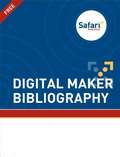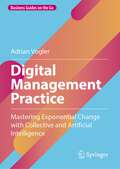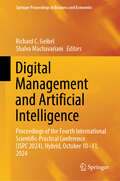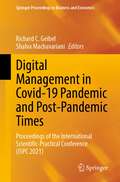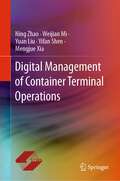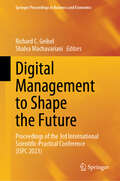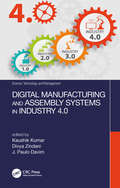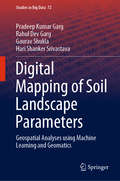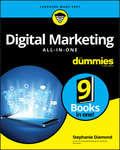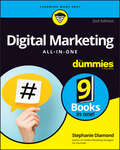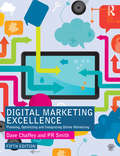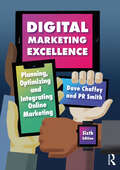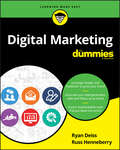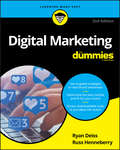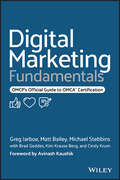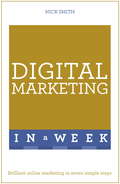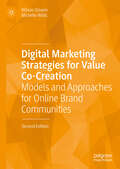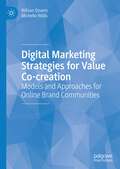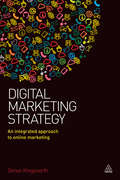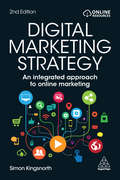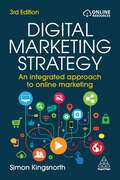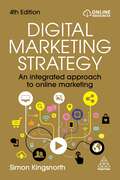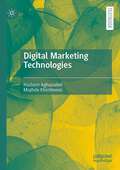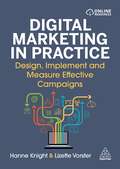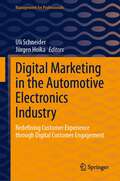- Table View
- List View
Digital Maker Bibliography
by Safari Content TeamDigital Makers experiment at the intersection between the creative and the practical. They are driven by curiosity and playfulness, by manifesto pledges to fail fast and fail often. To bring new designs into reality, they must draw upon inspiring and insightful contributions from a wide variety of fields; art, design, science or technology, before applying them with laser-focus to the particular problem they have in mind.As part of their craft, makers must tackle issues of materials science, algebra, logic and a myriad of other subjects every day as part of their inventive leisure activities. Of course, this means drawing a boundary around the knowledge relevant to 'making' represents an impossible task. Instead, this bibliography attempts to summarize and explain the recurring themes that have emerged from the craft and have become fascinations for makers the world over. These are the tools, techniques, deployment domains, audiences and ways of thinking which are chosen over and over again for their power, accessibility, flexibility, elegance, or cool factor.
Digital Management Practice: Mastering Exponential Change with Collective and Artificial Intelligence (Business Guides on the Go)
by Adrian VoglerThe book illustrates how managers and knowledge workers can effectively harness collective and artificial intelligence to counteract the effects of exponential change and successfully implement digitization within their organizations. The author applies the proven management principles of Peter F. Drucker to the new challenges of the digital age, enhancing them with the concepts of collective and artificial intelligence. This approach also takes into account the insights of Daniel Kahneman regarding "Thinking, Fast and Slow" and the associated cognitive biases and deficits in human thinking. By leveraging innovative tools – collective and artificial intelligence – these deficits can be mitigated, aiding in decision-making. The use of these tools in innovation management and work organization is also discussed. Readers are provided with practical tips and strategies for implementation. Embark on an exciting journey through digital management practices and successfully navigate the challenges of the digital world.
Digital Management and Artificial Intelligence: Proceedings of the Fourth International Scientific-Practical Conference (ISPC 2024), Hybrid, October 10-11, 2024 (Springer Proceedings in Business and Economics)
by Richard C. Geibel Shalva MachavarianiThis book presents selected contributions from the Fourth International Scientific-Practical Conference (ISPC 2024), held on October 10–11, 2024, organized by IU International University, East European University, Adelphi University, and the E-Commerce Institute, with contributions from Asia, Africa, Europe, and the USA. It discusses the challenges and opportunities of digital transformation and AI in different industries and introduces advanced research and solutions from both academic and professional perspectives. The topics covered include artificial intelligence, digitalization in healthcare, legal systems, corporate responsibility, e-commerce, digital entrepreneurship, and digital transformation in education. One key topic is social commerce, including live shopping, as a blend of social media and e-commerce. The interaction between digitalization and sustainability is also explored. The growing influence of artificial intelligence in the financial sector is examined as well. Additionally, investigations into the impact of digitalization on the education sector and the labor market are included. All studies focus on the unique opportunities presented by digitalization and describe how these new potentials can be translated into concrete benefits. The book is an engaging read for researchers and professionals interested in digital management, one of the most significant developments of recent times.
Digital Management in Covid-19 Pandemic and Post-Pandemic Times: Proceedings of the International Scientific-Practical Conference (ISPC 2021) (Springer Proceedings in Business and Economics)
by Richard C. Geibel Shalva MachavarianiThis book presents select contributions of the International Scientific-Practical Conference 2021 (ISCP 2021) organized by East European University (Georgia) and Fresenius University of Applied Sciences (Germany). It discusses the challenges of digital transformation during and after the pandemic and introduces advanced research and solutions from both academic and professional’s aspects. The topics covered include digitalization in social and corporate responsibility, e-commerce and digital entrepreneurship, and digitalization in education.The book is an interesting read for researchers and professionals interested in digital management.
Digital Management of Container Terminal Operations
by Ning Zhao Yuan Liu Weijian Mi Yifan Shen Mengjue XiaThis book presents a comprehensive study on intelligent container terminals. Based on the development experience gained to date with container terminals, it analyzes information flows and their interactions with container terminals; illustrates the operation management process from information collection to resource planning and from equipment scheduling to field operation; highlights several dynamic decision-making problems concerning digital operation processes and container terminals; reveals the basis of the discrete logistics system; and discusses the future of intelligent container terminals.
Digital Management to Shape the Future: Proceedings of the 3rd International Scientific-Practical Conference (ISPC 2023) (Springer Proceedings in Business and Economics)
by Richard C. Geibel Shalva MachavarianiThis book presents selected contributions to the International Scientific-Practical Conference 2023 (ISCP 2023) organized by East European University (Georgia), E-Commerce Institute (Germany) and Adelphi University (USA). It discusses the challenges and opportunities of digital transformation in various industries and introduces advanced research and solutions from both academic and professional perspectives. The topics covered include digitalization in health care, legal systems, corporate responsibility, e-commerce, digital entrepreneurship, and digital transformation in education, with a significant focus on social commerce—encompassing live shopping as a fusion of social media and e-commerce. A dedicated chapter examines and describes the interaction between digitalization and sustainability. The growing influence of artificial intelligence in the financial sector is discussed. Moreover, it investigates the influence of digitalization on the education sector and the labor market. The book focuses on the special opportunities presented by digitalization and describes how the resulting new potential can be translated into tangible benefits. It is an interesting read for researchers and professionals interested in digital management as one of the most important developments of recent times.
Digital Manufacturing and Assembly Systems in Industry 4.0 (Science, Technology, and Management)
by J. Paulo Davim Kaushik Kumar Divya ZindaniManufacturing, like other industries, is rising to the challenges imposed by aggressive consumer demands and the need for cost-effective processing that delivers quality in the fastest possible time. Fierce competition means that keeping abreast of new developments and applications in technology is essential if companies are to meet demands profitably and keep ahead of competitors. This book investigates the design and management of digital manufacturing and assembly systems for an efficient, flexible, and modular production of customized products using the I40 (industry 4.0)-enabling technologies. This book will also provide case studies covering modeling, simulation, and optimization. eBook includes color figures. Discusses how the advancement of data communication and storage through the Internet of Things (IoT) opens the possibilities of connecting sensors, robots, and devices Sheds light on how the human role in industry is decreasing due to the development of connected manufacturing floors, allowing them to take more control over the manufacturing processes, decisions, and even maintenance Covers the benefits from exploiting digital manufacturing, manufacturing enterprises, and what they expect to achieve Explains the important roles that modeling, simulation, and optimization play Investigates the design and management of digital manufacturing and assembly systems for an efficient, flexible, and modular production of customized products exploiting the I40 (industry 4.0)-enabling technologies
Digital Mapping of Soil Landscape Parameters: Geospatial Analyses using Machine Learning and Geomatics (Studies in Big Data #72)
by Pradeep Kumar Garg Rahul Dev Garg Gaurav Shukla Hari Shanker SrivastavaThis book addresses the mapping of soil-landscape parameters in the geospatial domain. It begins by discussing the fundamental concepts, and then explains how machine learning and geomatics can be applied for more efficient mapping and to improve our understanding and management of ‘soil’. The judicious utilization of a piece of land is one of the biggest and most important current challenges, especially in light of the rapid global urbanization, which requires continuous monitoring of resource consumption. The book provides a clear overview of how machine learning can be used to analyze remote sensing data to monitor the key parameters, below, at, and above the surface. It not only offers insights into the approaches, but also allows readers to learn about the challenges and issues associated with the digital mapping of these parameters and to gain a better understanding of the selection of data to represent soil-landscape relationships as well as the complex and interconnected links between soil-landscape parameters under a range of soil and climatic conditions. Lastly, the book sheds light on using the network of satellite-based Earth observations to provide solutions toward smart farming and smart land management.
Digital Marketing All-In-One For Dummies
by Stephanie DiamondUnlock the value in online marketing A well-executed digital marketing plan is a proven component of success in business, and Digital Marketing All-In-One For Dummies covers everything you need to build and implement a winning plan. Whether you’re a novice in the online space or an expert marketer looking to improve your digital ROI, this book has easy-to-absorb tips and insights that will turn online prospects into loyal customers. This book compresses the essential information on 8 topics, so you have all the information you need and none of what you don’t. You’ll learn social media marketing, marketing to millennials, account-based marketing, influencer marketing, content marketing strategies, and more! Use targeted, measurable marketing strategies to promote brands and products Increase brand awareness, customer acquisitions, and audience engagement Measure what your online traffic is worth and improve ROI on digital marketing Develop a solid digital marketing plan and put it to work for your brand From SEO and SEM to brand awareness and why you need it, Digital Marketing All-In-One For Dummies will help you level up your digital marketing game and avoid the common mistakes that might be holding your business back.
Digital Marketing All-In-One For Dummies
by Stephanie DiamondDevelop and refine your comprehensive online marketing plan With more than 800 content-packed pages, Digital Marketing All-in-One For Dummies is the most comprehensive tool for marketers looking to beef up their online presence. In this edition, you’ll learn the latest trends in digital marketing strategies, including brand new insight on how to incorporate artificial intelligence into your marketing plans. You’ll also get the latest information on how to manage your customers’ experiences, create exceptional marketing content, get help from influencers, and leverage social accounts for more followers and greater profits. With the help of this friendly Dummies guide, you’ll accelerate your journey from traditional to digital marketing processes, uncover tips to prove ROI of marketing activities, and increase audience engagement. Build and implement a winning digital plan for your brand Learn how to establish an online presence with social media Turn online prospects into loyal customers Target consumers in any market segment and age bracketDig into the latest marketing advice as you provide your potential and existing customers the kind of personal experience you look for as a customer.
Digital Marketing Excellence: Planning, Optimizing and Integrating Online Marketing
by Pr Smith Dave ChaffeyNow in its fifth edition, the hugely popular Digital Marketing Excellence: Planning, Optimizing and Integrating Online Marketing is fully updated, keeping you in line with the changes in this dynamic and exciting field and helping you create effective and up-to-date customer-centric digital marketing plans. A practical guide to creating and executing digital marketing plans, it combines established approaches to marketing planning with the creative use of new digital models and digital tools. It is designed to support both marketers and digital marketers, and students of business or marketing who want a thorough yet practical grounding in digital marketing. Written by two highly experienced digital marketing consultants, the book shows you how to: Draw up an outline digital marketing plan Evaluate and apply digital marketing principles and models Integrate online and offline communications Implement customer-driven digital marketing Reduce costly trial and error Measure and enhance your digital marketing Learn best practices for reaching and engaging your audiences using the key digital marketing platforms like Apple, Facebook, Google and Twitter. This new edition seamlessly integrates the latest changes in social media technology, including expanded coverage of mobile technology, demonstrating how these new ways to reach customers can be integrated into your marketing plans. It also includes new sections on data analytics, clearly demonstrating how marketers can leverage data to their advantage. Offering a highly structured and accessible guide to a critical and far-reaching subject, Digital Marketing Excellence, Fifth Edition, provides a vital reference point for all students and managers involved in marketing strategy and implementation.
Digital Marketing Excellence: Planning, Optimizing and Integrating Online Marketing
by Dave Chaffey PR SmithNow in its sixth edition, the hugely popular Digital Marketing Excellence is a practical guide to creating and executing integrated digital marketing plans, combining established approaches to marketing planning with the creative use of new digital models and digital tools. Written by two highly experienced digital marketing consultants, the book shows you how to: Draw up an outline integrated digital marketing plan Evaluate and apply digital marketing principles and models Integrate online and offline communications Implement customer-driven digital marketing as part of digital transformation Reduce costly trial and error Measure and enhance your digital marketing Learn best practices for reaching and engaging your audiences using the key digital marketing platforms. This new edition has been streamlined to seamlessly integrate the latest developments in digital analytics, ethics and privacy, Predictive Analytics, Machine Learning and Artificial Intelligence. Including new international case studies and up-to-date examples throughout, this book cuts through the jargon to show marketers how to leverage data and digital technologies to their advantage. Offering a highly structured and accessible guide to a critical and far-reaching subject, Digital Marketing Excellence, 6th edition, provides a vital reference point for all digital marketing students, and managers involved in digital marketing strategy and implementation. Online resources have been fully updated for the new edition and include a new set of PowerPoint slides and a full test bank of questions and exercises.
Digital Marketing For Dummies
by Russ Henneberry Ryan DeissDoes your digital marketing pack a punch? Written with the marketer's best interests in mind, this friendly, down-to-earth guide shows you how to use proven digital marketing strategies and tactics to expand the reach of your brand, increase audience engagement, and acquire and monetize customers. From current best practices in SEO and SEM to the latest ways to effectively use content marketing and influencer marketing—and everything in between—Digital Marketing For Dummies helps you get the most out of all your digital marketing efforts. What worked in digital marketing just a few years ago is quickly losing relevance as electronic platforms—and the people who use them—continue to evolve. So how do you keep afloat in this fast-paced and ultra-competitive environment? Don't sweat it! Digital Marketing For Dummies takes the guesswork out of marketing in the digital age, offering the latest tips and techniques for utilizing technology to get your product or services out to the masses. Whether you're looking to craft a killer campaign from scratch or just want to beef up your social media presence, you'll find everything you need to meet your business goals—and boost your bottom line. Develop an individually tailored digital marketing campaign Offer an effective lead magnet to convert visitors Keep your audience invested in your brand, products, and services Create a return path with frequent and strategic communication with your customers If you're ready to benefit from the latest and greatest digital marketing has to offer, this no-nonsense guide sets you up for success.
Digital Marketing For Dummies
by Russ Henneberry Ryan DeissGet digital with your brand today! Digital Marketing for Dummies has the tools you need to step into the digital world and bring your marketing process up to date. In this book, you’ll discover how digital tools can expand your brand’s reach and help you acquire new customers. Digital marketing is all about increasing audience engagement, and the proven strategy and tactics in this guide can get your audience up and moving! You’ll learn how to identify the digital markets and media that work best for your business—no wasting your time or money! Discover how much internet traffic is really worth to you and manage your online leads to convert web visitors into paying clients. From anonymous digital prospect to loyal customer—this book will take you through the whole process! Learn targeted digital strategies for increasing brand awareness Determine the best-fit online markets for your unique brand Access downloadable tools to put ideas into action Meet your business goals with proven digital tactics Digital marketing is the wave of the business future, and you can get digital with the updated tips and techniques inside this book!
Digital Marketing Fundamentals: OMCP's Official Guide to OMCA Certification
by Greg Jarboe Matt Bailey Michael StebbinsPrepare for the OMCP certification exam and expand your digital marketing skillset Courses relying on the OMCP Digital Marketing Certification standards attract over 70,000 students at 900 universities around the world each year. This challenging curriculum requires strong command of content marketing, conversion rate optimization, and other digital marketing competencies in high market demand. In Digital Marketing Fundamentals, veteran digital media and marketing experts Greg Jarboe, Michael Stebbins, and Matt Bailey deliver an essential and accessible roadmap to completing the highly sought-after OMCP Digital Marketing Certification. You’ll explore topics like digital analytics, social media marketing, and search engine optimization with the help of industry-leading authors and members of the OMCP Standards Committee. In the book, you’ll also find: Full discussions of paid search marketing, email marketing, and marketing to mobile device users Exacting and focused instruction on all the competencies tested by the OMCP exam Accessible content suitable for experienced digital marketers looking for a new certification to boost their career, as well as novice practitioners trying to expand their skillsetPerfect for aspiring and practicing digital marketers, Digital Marketing Fundamentals also belongs in the libraries of entrepreneurs, solopreneurs, and other small- and medium-sized business leaders looking for a starting point into the critical world of digital marketing.
Digital Marketing In A Week: Brilliant Online Marketing In Seven Simple Steps
by Nick SmithDigital Marketing In A Week is a simple and straightforward guide to brilliant digital marketing, giving you everything you need to know in just seven short chapters. From social marketing and search engine optimization, to 'paid' advertising, mobile marketing and creating the perfect website for driving sales, you'll discover the perfect toolkit to drive your successful digital marketing.This book introduces you to the main themes and ideas of digital marketing, giving you a knowledge and understanding of the key concepts, together with practical and thought-provoking exercises. Whether you choose to read it in a week or in a single sitting, NLP In A Week is your fastest route to success:- Sunday: Building the ultimate sales website- Monday: SEO: The backbone of any digital marketing strategy- Tuesday: Social media marketing madness- Wednesday: Pay per click (PPC) simplified and explained- Thursday: Mobile optimization and getting mobile users- Friday: Email marketing - why you should do it no matter what- Saturday: Other marketing tricks and tips in the modern worldABOUT THE SERIESIn A Week books are for managers, leaders, and business executives who want to succeed at work. From negotiating and content marketing to finance and social media, the In A Week series covers the business topics that really matter and that will help you make a difference today. Written in straightforward English, each book is structured as a seven-day course so that with just a little work each day, you will quickly master the subject. In a fast-changing world, this series enables readers not just to get up to speed, but to get ahead.
Digital Marketing Strategies for Value Co-Creation 2e: Models and Approaches for Online Brand Communities
by Wilson Ozuem Michelle WillisAmidst growing conceptual developments in the areas of value co-creation and digital marketing, the importance of Online Brand Communities (OBCs) has emerged to reinforce strategies. This book provides an introduction to a range of broad and debatable conceptual perspectives and mechanisms on the subject of OBC. Focusing on contemporary digital marketing issues, it offers a comprehensive examination of consumers’ response to active engagement in such communities. Building on the very successful original publication, this thoroughly revised second edition includes two new chapters on data-driven segmentation and artificial intelligence and customer engagement. The book balances theory with practical approaches and gives serious treatment to an important area of digital marketing strategy, providing an important resource for scholars, students and practitioners.
Digital Marketing Strategies for Value Co-creation: Models and Approaches for Online Brand Communities
by Wilson Ozuem Michelle WillisOnline brand communities (OBCs) are hugely important in the development of marketing strategy, but it is unclear how marketers can effectively utilise these platforms to enhance and develop consumer engagement. For an online brand community to be successful, it should allow members to feel a connection to the brand and with other members while forming a disconnection from those not belonging to the community. It should also have rituals and traditions that join members together over a revered commonality, and moral responsibility in contributing to the community. Indeed, brands play active roles in securing degrees of activity in OBCs’ through content that offers members the quality of engagement they seek. This book focuses on contemporary digital marketing issues in OBCs, offering a comprehensive examination of consumers’ response to active engagement in such communities. It discusses how brands can tap into the various levels of participation, engagement and online conversations in the development of marketing strategy and ultimately examines how an online brand community strengthens value co-creation. Balancing theory with practical approaches, this book gives serious treatment to an important yet until now overlooked area of digital marketing strategy, providing an important resource for scholars, students and practitioners.
Digital Marketing Strategy: An Integrated Approach to Online Marketing
by Simon KingsnorthThe modern marketer needs to learn how to employ strategic thinking alongside the use of digital media to deliver measurable and accountable business success. Digital Marketing Strategy covers the essential elements of achieving exactly this by guiding you through every step of creating your perfect digital marketing strategy. It contains analysis of the essential techniques and platforms of digital marketing including social media, content marketing, SEO, user experience, personalization, display advertising and CRM, as well as the broader aspects of implementation including planning, integration with overall company aims and presenting to decision makers.Simon Kingsnorth brings digital marketing strategy to life through best practice case studies, illustrations, checklists and summaries, to give you insightful and practical guidance. Rather than presenting a restrictive 'one size fits all' model, this book gives you the tools to tailor-make your own strategy according to your unique business needs and demonstrates how an integrated and holistic approach to marketing leads to greater success.
Digital Marketing Strategy: An Integrated Approach to Online Marketing
by Simon KingsnorthEffectively select, align and manage digital channels and operations using this second edition of the bestselling guide, Digital Marketing Strategy. This accessible, step-by-step framework enables the planning, integration and measurement of each digital platform and technique, all tailored to achieve overarching business objectives. Ranging from social media, SEO, content marketing and user experience, to customer loyalty, automation and personalization, this edition features cutting edge updates on marketing automation, messaging and email, online and offline integration, the power of technologies such as AI, plus new data protection and privacy strategies. Accompanied by downloadable templates and resources, Digital Marketing Strategy is an ideal road map for any marketer to streamline a digital marketing strategy for measurable, optimized results. Online resources include lecture slides, activity sheets, practical implementation guides and templates, which will be regularly updated to equip readers as digital marketing continues to evolve.
Digital Marketing Strategy: An Integrated Approach to Online Marketing
by Simon KingsnorthBuild an effective and practical digital marketing strategy with this bestselling guide, covering everything from automation and analytics to integrating AI. Digital Marketing Strategy is a global bestseller, and a one-stop guide to structuring and building a more strategic approach to digital marketing. Now fully updated, this third edition covers the integration of AI in marketing, e-commerce, marketing automation, affiliate marketing and how to use digital analytical tools, plus new strategies for the latest cookie changes and privacy protection. Digital Marketing Strategy will show you how to effectively select, align and manage digital channels and operations, to streamline a successful digital marketing strategy for measurable, optimized results. Recommended by the Chartered Institute of Marketing (CIM), it is supported by real-world case studies from the likes of Coca-Cola, Spotify, Airbnb, Adidas and Hostelworld as well as checklists, key terms and insights from leading industry practitioners to help you develop your own digital marketing strategy. This book is an invaluable guide for both digital marketing students and entry-level to mid-management marketing professionals. Accompanying online resources consist of practical implementation guides spanning SEO, paid-search, email, lead-generation, as well as presentation slides and activity sheets.
Digital Marketing Strategy: An Integrated Approach to Online Marketing
by Simon KingsnorthReady to develop and implement a digital marketing strategy that elevates your career?Digital Marketing Strategy is a practical guide designed for mid-career professionals seeking to build credibility and lead with confidence. Written by marketing expert Simon Kingsnorth, the fourth edition of his top-rated manual offers detailed models and frameworks to help you apply strategic principles across AI integration, marketing automation and digital analytics. With fresh real-world examples and actionable tools, it empowers you to optimize your digital marketing efforts and deliver measurable impact.You'll learn how to: - Develop a strategic digital marketing plan using proven frameworks- Implement AI-driven tools to enhance campaign efficiency- Optimize marketing performance with data-backed decision making- Build career credibility through advanced digital marketing skills- New to this edition: Use AI to build a strategy, the metaverse, Web3 and NFTs, plus updates to data points, platform features and real-world examplesWith comprehensive chapters and supportive online resources, this guide equips you to navigate emerging digital trends while driving tangible results in your organization and career.Themes include: Digital marketing strategy, AI integration and marketing automation, Practical frameworks and tools, Career development and impact, Real-world case studies
Digital Marketing Technologies
by Hashem Aghazadeh Mozhde KhoshnevisThis book argues that digital marketing should benefit from emerging technologies to result in sustainable competitive values for businesses in both the digital and physical worlds. It not only explores digital marketing fundamentals, analysis, strategy, practices, and implementation but also explains the applications and relationships of marketing technologies (martechs) with digital marketing; as well as offers several real cases of practicing marketing technologies. It carefully describes how modern businesses offer their value propositions both digitally and physically applying emerging technologies specifically marketing technologies (martechs) and how consumers are using these new technologies particularly artificial intelligence (ChatGPT/ OpenAI). It investigates why consumers are so intrigued and interested in digital relationships, interaction, and shopping experiences. It critically examines and argues that digital marketing has become popular among businesses as they areattempting to serve their customers better by taking advantage of using digital marketing technologies (marketchs).
Digital Marketing in Practice: Design, Implement and Measure Effective Campaigns
by Hanne Knight Lizette VorsterLearn how to create effective digital marketing campaigns, analyze competitor behaviour and conduct digital marketing in a responsible and accountable way with this real-life focussed and streamlined textbook.Digital Marketing in Practice balances step-by-step practical coverage with academic theoretical context throughout to offer a definitive and easy-to-understand resource. Exploring key definitions and best-practice for tools, channels and platforms including SEO, social media marketing, email marketing and online advertising, it shows how to create plans and set objectives, design digital marketing campaigns and evaluate their success for improvement.Digital Marketing in Practice also describes how to incorporate accountability, inclusivity and meaningful sustainability messaging. Featuring interviews with industry professionals and case study examples from a range of brands including Nielsen and the Met Office, it also contains how-to guides, check lists and critical thought pieces.Supported by online resources consisting of lecture slides, self-test questions, group activities, worksheets, additional interactive case studies and further resource links, it is an indispensable text to equip students with the tools to develop and implement successful digital marketing.
Digital Marketing in the Automotive Electronics Industry: Redefining Customer Experience through Digital Customer Engagement (Management for Professionals)
by Uli Schneider Jürgen HoikaThe book complements the current body of knowledge in business-to-business marketing with the experience of many professionals ranging from marketers to top management of a leading automotive semiconductor supplier worldwide. It presents unique and adaptable practical concepts, case studies, and tested models from practice. The book operationalizes the theory of approaches such as omni-channel marketing, and target driven performance marketing into practical and actionable approaches in large B2B companies in automotive sectors. The change management nature of the digital transformation of marketing is a common thread throughout the book and the experience of more than 10 practitioners, allowing readers to relate the content directly to their own business reality.
